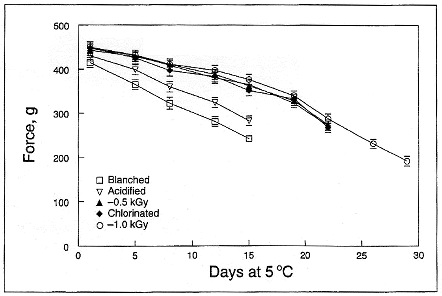さらに、カットセロリーにEscherichia coli及びListeria monocytogenesを接種した後に1.0kGyのガンマ線を照射すると、これらの病原菌を検出限界以下にまで減少させることができる。
D Control 1.0kGy 0.5kGy Acidified Blanched Chlorinated 1
5
8
12
15
19
22
SEMb6.57a
6.78b
8.95a
8.65a
8.58a
8.72a
8.44b
0.092.00c
2.00e
3.91e
5.37e
6.35c
6.74c
6.45c
0.164.81b
5.58c
5.92d
6.30d
6.53c
5.69d
6.49c
0.032.00c
4.58d
6.68c
7.04c
7.48b
7.90b
8.17b
0.126.30a
7.48a
7.17b
7.80b
8.61a
8.70a
8.92a
0.066.41a
7.23a
7.46b
8.35a
8.60a
8.82a
9.32a
0.10a-eMeans of 4to 6plates.Values in the same row that are followed by the same letter are not significantly different(P<0.05).
SEMb-Standard error of the mean calculated by pooling variances across time points
ガンマ線は他の処理に比べて色調、香気、テクスチャーに対する影響が小さく、ガンマ線照射による殺菌効果のために微生物による品質劣化も抑制されるので、セロリーの商品寿命は1kGy照射で29日となり、無処理と塩素処理の22日、酸処理とブランチングの15日と比べて延長される。なお、0.5kGy照射したセロリーの商品寿命は22日である。
D 0kGy 0.5kGy 1.0kGy 1
4
7
11
14
20
SEMb5.54a
5.53a
5.28a
5.40a
5.15a
4.98a
0.162.40b
2.60b
2.70b
3.54b
4.18b
3.20b
0.210.00c
0.00c
0.00c
0.00c
2.18c
0.00c
0.0a-eMeans of 4to 6plates.Values in the same row that are followed by the same letter are not significantly different(P<0.05).
SEMb-Standard error of the mean calculated by pooling variances across time points
